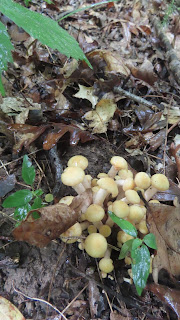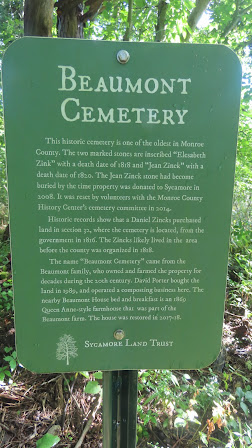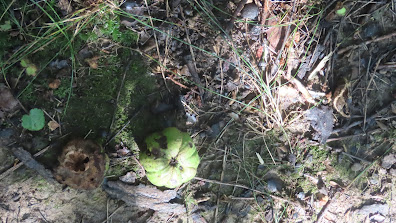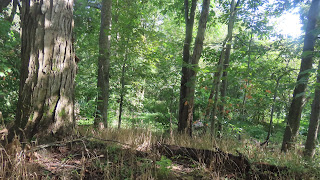The first in a series of undetermined length, through which I share nature trail ramblings as I physically improve, upping my goals as I go along.
Fulfilling the First Goal:
Porter West Nature Preserve
Monroe County, Indiana
August 18, 2024
It has been a while since I have provided a blog post about a current or recent trail walk.
That's because I had not been able to do trail walks much. I had developed hip/leg problems that prevented me from doing so many of the things I need and want to do. Walking any distance was painful and exhausting, and much worse on hard surfaces.
The source of the problem had been a mystery, and there still is a bit of mystery. But thanks to the wonders of physical therapists, and my persistence with the exercises they recommended, I'm getting there! I can now remember what it's like to walk across a room in a normal fashion, with little or no pain. I am fortunate that this was something physical therapy and the right exercises could remedy (mostly), but if it were otherwise, my determined self would figure out a way to adapt. However, I wanted to get to the root of the problem first and make sure I would not do further harm to myself.
One of the goals I had for myself, after some weeks of physical therapy, was to walk a trail on a natural surface for at least a mile. My husband and I connected with our daughter in Bloomington, Indiana (Monroe County) to see where she might like to walk, too. Some possibilities were eliminated because they were too short, or paved trails, or would take too long to get to, or were too steep, which I would normally prefer. But I needed to be careful, not make things worse, and take this progress one goal at a time.
Our daughter suggested Porter West Preserve, one of her favorite places, so off we went. It is a very short drive from town, yet is a quiet get-away. We had been there once before.
Porter West Preserve is part of Sycamore Land Trust, a non-profit organizations that currently protects over 11,400 acres in a 26-county area in southern Indiana. This includes 56 nature preserves, of which 13 are public preserves with miles of hiking trails. SLT offers guided hikes at some.
From the Sycamore Land Trust Nature Preserve Guide: 2024 Edition (available for free at the trail head.)
Porter West is 188 acres of variety in Monroe County. There are two general areas to hike. One is a trail of more variable terrain in hilly, mature forest. We have not yet hiked that area, but it will be one of my later goals. It adds up to about two miles, but it's mainly a later goal due to the terrain. I would love to do that one during spring wildflower season.
Due to my current goal, we did the trail we walked once before, in the lower area. Part of it skirts the mature forest, but the rest is successional habitat, some of it pretty new, transitioning from an open area that had been a composting business. I find it interesting to see what's going on in the liminal area between forest and former open area, and how the latter has changed since our previous visit.
This area's trail, about 1 ½ miles, is mostly fairly level, so it fit the bill for this walk. It also passes closely by a cluster of ponds and has a tiny, mowed side trail to an historic cemetery, which interested all three of us.
We took the opposite direction around the loop from last time, moving toward the forest first, though we would first go through some of the more open, shrubby area.
Non-native but naturalized Chicory (Cichorium intybus), introduced from Europe.
This shows the kind of environment prevalent in the more open area.
These areas are sunnier, and trees tend to be very young, so there is an abundance of bright blooms, especially at this time of year.
Tall Ironweed (Vernonia gigantea)
In this area there is also evidence of an old home site. On one spot near the trail there were limestone blocks, some still stacked, some fallen or scattered, that may have been the foundation of a house, or maybe a barn or other outbuilding.
Another way to identify old home sites is by the occurrence of certain plants.
Yucca (Yucca flaccida), a.k.a. Adam's Needle
Garlic Chives (Allium tuberosum), native to southeast Asia, a.k.a. Chinese Chives.
Where the trail splits. Veer right to go up into the forested hills, or left to skirt the edge of the forest and further explore the open areas. Veer left and explore with us.
Wingstem (Verbesina alternifolia)
Black-eyed Susan (Rudbeckia hirta)
One of the common native shrubs, Spicebush (Lindera benzoin),with both green and ripe red berries, which are attractive to birds. This is a very aromatic shrub, which you can easily experience by crushing a leaf or scratching and smelling a twig. The leaves will turn yellow soon.
Now we enter the forested area where we'll see mature trees, different kinds of plants and fungi, and other features.
Entering the woods
One of the interesting features here, in this karst topography, is sinkholes. Many ferns can be seen around sinkholes. At this one there are Christmas Ferns (Polystichum acrostichoides).
Jumpseed/Virginia Knotweed (Persicaria virginiana) and Elephant's Foot (Elephantopus carolinianus).
Elephant's Foot
Some plants are going to fruit and seed (I do not know the species of this one.)
White Baneberry/Doll's Eyes (Actaea pachypoda).
Turkey Tail fungus (Trametes versicolor). Turkey Tail appears in a wide variety of colors and striping.
We have reached the spot where the power lines go through the forest (and on to the open area), where an open, sunny corridor has been created full of flowering plant (both native and non-native.)
Then the trail goes back into the forest, where we find an overturned tree. The area of tree roots in the ground is a rich habitat, full of beneficial relationships between roots, fungi, other plants, microorganisms, and small animals. Now that the area is exposed, it will be used as habitat in some different ways.
Indian Tobacco in bloom (Lobelia inflata).
Going up the forest trail, through spots of dappled sun.
A lichen-covered branch on the ground with pale Turkey Tail fungus (Trametes versicolor), very different from the Turkey Tail we saw previously. There is also a sprig of brown evergreen across the branch. We have entered an area of evergreens, and the forest floor changes with the soft cover of brown needles.
Large, errant chunk of limestone. Don't know why it's there, but it's a good spot to stop and rest, and observe the surroundings.
A stony crevice appears, where separation and erosion have opened a deep slice through the now moss-covered limestone.
A jelly fungus that I call “Root Beer Fungus”, but that's not the accepted name.
Turning south through the forest, we walked through a downpour!! We didn't mind - it was refreshing.
A bolete type of mushroom (densely porous on the underside.) Noticeably, we saw much more fungi in the forested section.
Naturally eroded ridge.
Agrimony in bloom (genus Agrimonia.) I'm not sure of the species, but am wondering if it is Woodland Agrimony (A. rostellata).
In this area, we came across a little Sensitive Fern now and then (Onoclea sensibilis).
An American Sycamore (Platanus occidentalis), my favorite tree, had fallen across the trail during recent storms and had been cut to reopen the trail. This provided a close-up view of the upper reaches of the tree, where the bark is white and glows in the upper reaches of the forest. The lower parts of the tree have variegated, peeling bark, sometimes making the trunk look like it is wearing camo.
We have come all the way down through the forest and have reached the ponds. These ponds seem much more wild than the last time we saw them, when there was more debris along some edges.
It would be interesting to stay at them longer to watch and listen.
The trail curves around at the bottom, heading toward the open area again, and a wide, mowed path.
Onto the mowed trail …
We will again see more colorful blooms in this sunnier area, including species adapted to the wetter spots. We will also, unfortunately, see more invasive species that have been invading this area for years, at the edge of the preserve.
Orange/Spotted Jewelweed (Impatiens capensis) likes wet areas. Hummingbirds and long-tongued insects, like some species of native bees, can reach the nectar way down into the spur.
Jerusalem Artichoke/Sunchoke/Sun Root (Helianthus tuberosus) is a native sunflower species with tubers growing on its roots that are edible. These are highly nutritious. Well, I think this is H. tuberosus. There are so many native sunflower species, sometimes hard to tell apart.
Pokeweed (Phytolacca americana), a very common native plant along edges, in yards, in many places, that grows rather tall. This one shows both the flowers and the unripe, green berries. Also present at the preserve were Pokeweed plants with the ripe, inky, purple/black berries, loved by birds.
Ironweed is prevalent along the sunny trail edges, and so brightly purple this time of year. Vines, both native and non-native, are also more noticeable along the edges.
Horse Nettle (Solanum carolinense), growing in the trail, is a common native “weed”, and you do not want to encounter it while barefoot! This tomato relative gets very small, yellow fruit that are toxic to eat.
A very common, profuse invasive vine, Japanese Honeysuckle (Lonicera japonica). The flowers smell heavenly and have sweet nectar, but the plant is a menace, overtaking areas.
Some composite flowers, which are prevalent this time of year (Family Asteraceae):
Fleabane (Genus Erigeron) – not sure of species
Late Boneset (Eupatorium serotinum)
Grass-leaved Goldenrod (Euthamia graminifolia).
Some non-native invasive plants (one I'm not sure about):
Crown Vetch (Coronilla varia) – introduced by agriculture
Teasel (Dipsacus fullonum), with dry seed heads. This plant is a common invasive species in this part of Indiana. It was brought by settlers who used the heads to comb wool.
Thistle (Genus Cirsium). Native or non-native? The non-native species tend to be invasive. I'm not sure of the species, but it could be the native Field Thistle (C. discolor).
A beautiful native, Swamp Milkweed (Asclepius incarnata) feeds Monarch butterfly caterpillars and is a popular plant for many other insect species. This view is zoomed in – the plant is closer to the pond area.
Queen Anne's Lace (Daucus carota) growing in the trail. This plant is not native, but has been naturalized for so long in North America that some consider it native. This is the same species as the domestic carrot. This plant resembles many others in the Apiaceae family, including some very toxic ones. But, the head of tiny white Queen Anne's Lace flowers often has one tiny maroon flower in the center.
Everlasting Pea (Lathyrus latifolius), a non-native. We are not far from the highway (State Road 48), and also nearing a residence.
We cross through the southern end of the power line cut-away area.
We see more shrubs:
I do not know the identification of this one, with the pretty, shiny berries. I hope it is a native species, but I suspect it is not.
A Dogwood tree (Genus Cornus) – I do not know the species.
A pretty collection of native blooms along the edge of the mowed trail.
Now we reach some private property (the white, cut-away area at the bottom of the map), a pretty area with a few buildings. It looks like it has been a church, maybe a small camp. It would make a nice B&B. It was recently for sale, but we do not know if it was still on the market at this time. Is this the Beaumont House??
There is some Giant Ragweed (Ambrosia trifida), a native but troublesome-to-humans plant on the right, with flowering, pollen-filled spikes, and a row of non-native, ornamental evergreens.
Back to the trail, with a mix of native and non-native (including invasive) plants. We are leaving the edge of the private property and going through the open, shrubby area, headed toward the trail head.
A carpet of invasive Creeping Charlie (Glechoma hederacea) with something growing in the middle. I'm strongly suspecting a non-native, ornamental plant, but I am not familiar with many ornamentals. It could have escaped from plantings on private property.
The pretty but very invasive species, Dame's Rocket (Hesperis matronalis).
For a stretch, the whole mowed path is a carpet of invasive Creeping Charlie. Edges of property, especially disturbed areas, that are near highways, construction, and other non-natural places, tend to accumulate invasive species that spread rapidly. They are brought on equipment, traffic, wind, and many other modes, or they have been planted nearby in landscaped spots.
Ah! A native species, the Eastern Red Cedar (Juniperus virginiana), which is, indeed, a juniper, not a cedar. The “berries” (that are actually cones) are preferred by Northern Mockingbirds, and the dense foliage makes for good, safe nesting for a number of birds. This is a pioneer species – often the first native tree species to populate a disturbed or open area that is left fallow.
Now we take an interesting little side trip to the historic Beaumont Cemetery, populated by Shagbark Hickory trees (Carya ovata):
Shagbark Hickory nuts
Heading away from the cemetery, back into the open, shrubby area, we see bright blooms again, and are soon back to the parking lot.
Pokeweed and Goldenrod
Possibly Late Goldenrod (Solidago gigantea).
Trail to parking lot
A path covered in another noxious invasive plant, Japanese Stiltgrass (Microstegium vimineum), which quickly overtakes opened areas and edges.
Clearweed (Pilea pumila), a native species related to nettles, but with no stinging hairs, is prevelant along this section of trail.
Evidence of previous uses of the land, here lies the remains of red cow statue. We do not know the story on this.
And there we have it, the lower loop trails of Porter West Nature Preserve, a little over a mile, with not much variation in terrain, but interesting changes along the way.
A long post, but … it's great to be back.
What is my next goal? Where will I go, to test how much better I am doing since the previous walk?
Likely somewhere a little longer, and hillier. It could be the upper loop trail of Porter West. It could be Trail 7 at Ouabache Trails Park in Knox County. It could be the recently reopened Trail 2 at McCormick's Creek State Park. Or the newer, upper trail of Bluffs of Beaver Bend Nature Preserve near Shoals. Or, one of the sandy trails at the Indiana Dunes. Or, one of many other options.
I know I'm not yet ready to walk for long on a hard surface, such as a paved trail, so I will continue testing myself on natural trails, only.
Stay tuned ...







































































































I'm so glad that you are starting to be able to get out and about again. I love the mixture of close observation and nature knowledge in this post (and of course the wonderful photos).
ReplyDelete